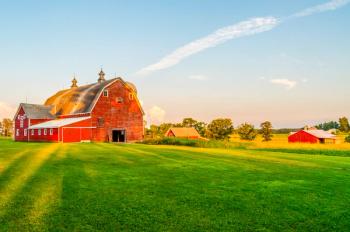
Plants poisonous to horses: the neurotoxic variety
This is the second in a series of articles introducing the toxic plants most likely to poison horses in North America.
This is the second in a series of articles introducing the toxic plants most likely to poison horses in North America.
Horses are relatively selective grazers and poisoning is comparatively rare, but when feed selection is restricted or when toxic plants are included in prepared feeds, many horses are poisoned.
Unlike the hepatotoxic plants described in the first article, most neurotoxic plants are palatable and produce specific, clinical disease and histologic lesions.
Here are some of them, along with associated clinical signs, lesions and sequelae of poisoning and recommendations for treatment and prognosis:
- 1. Centauria solstitialis (yellow-star thistle, Photo 1a), C. repens (Russian knapweed, Photo 1b), and C. melitensis (Malta star thistle).
Knapweed or yellow-star thistle intoxication is a disease of neglect, as horses must be forced to eat them. Poisoning occurs when horses are kept on a small pasture with limited feed.
Photo 1a: Centauria solstitialis (yellow-star thistle) is a Mediterranean weed that has become established in many western and southern states. It is invasive and dominates many roadsides and disturbed areas. Yellow-star thistle is a branching annual with finely haired leaves that are lobed basally and linear on the stem. The disc flowers are yellow and the bracts are tipped with stiff yellow spines. Photo 1b: Centaurea. repens (Russian knapweed) invades fields, pastures and roadsides. It is a persistent, noxious weed that grows in all soil types, spreads by both seeds and rhizomes and is allelopathic. A perennial, Russian knapweed is generally erect (~1 m tall) and the stems are covered with fine hairs. The leaves are alternate with serrated margins. The flowers form thistle-like heads (1 cm) and vary from white to purple. The paper-like bracts have no spines. Most seeds remain on the seed head, which is easily spread by animals.
As other forages are exhausted, some horses develop a taste for knapweed and may continue eating it even when supplemented with other forage.
At doses of 50 percent to 200 percent of their body weight over 30 to 90 days, horses develop dysfunction of facial, mouth and throat nerves and muscles.
This poisoning has been called "the chewing disease" (horses chew but can't swallow).
Next comes facial-muscle hypertonicity that causes "smiling," tongue lolling, protruding tongue and head tossing.Trying to drink, some horses submerge their muzzle in the water.
These early neurologic signs become worse and lead to lethargy, loss of interest in food, dehydration, malnutrition, difficulty breathing, incoordination, muscle tremors and severe depression.
Lesions include those of dehydration and starvation, in addition to damage to specific parts of the brain (the substancia nigra and globus pallidus — thus the name negropallidal encephalomalacia).
Horses are uniquely susceptible to this disease. The long exposures and lack of a smaller animal model have made it difficult to positively identify the toxin.
As there is no treatment and the disease is irreversible, it is best to avoid exposure to the plants for prolonged periods.
- 2. Astragalus and Oxytropis spp. (locoweeds).
Of the 500-plus Astragalus and Oxytropis species, about 20 are considered locoweeds (A. lentiginosus, Photo 2a; and O. sericea, Photo 2b).
Photo 2a: Astragalus lentiginosus (spotted locoweed) is a native plant that is well adapted to grow in the dry rocky areas of North America. It is a prolific seed-producer with long-lived seed banks. A perennial herb (~0.5 m) that has alternate and pinnately compound leaves, it has pealike flowers of variable numbers on axillary racemes. These develop into pods that contain small (2-4 mm) kidney-shaped seeds. Though growth patterns vary with location and precipitation, most germinate with the fall precipitation; remain green through the winter and mature early in the spring when other green feeds may not be available. Photo 2b: Oxytropis sericea (white-point locoweed).
Horses are uniquely sensitive and readily eat locoweeds, resulting in frequent poisoning. The locoweed toxin, swainsonine, inhibits cellular enzymes, resulting in impaired cellular metabolism and storage disease.
Signs of poisoning begin after several weeks' ingestion and include depression and reluctance to move. Many animals abort, have weak foals or foals with birth defects. With continued exposure, animals develop intention tremors, proprioceptive deficits, loss of condition with irreversible neurologic changes.
With stimulation, poisoned animals become neurologically unstable, with fits ranging from anxiousness to maniacal aggressive bouts, which are dangerous for the poisoned animal and by-standing animals or caretakers.
Many of the clinical signs resolve when exposure is discontinued, but previously poisoned animals may relapse with changes ranging from mild proprioceptive deficits to convulsive-like fits.
Diagnosis is easily made by documenting exposure and identifying the characteristic histologic changes. Swainsonine can be identified in blood and tissues of poisoned animals, but it is quickly cleared within days of discontinuing exposure. New biomarkers are being developed to better identify poisoning and predict recovery.
There are no treatments for locoweed poisoning. As horses have to ingest locoweed for several weeks to be poisoned, avoiding prolonged exposures is essential. Many previously poisoned animals can recover and function as reproductive animals. However, any poisoned animal is likely to have permanent neurologic lesions that will likely impair function. Previously poisoned horses should not be ridden or worked.
- 3. Leucoencephalomalacia (moldy corn).
This disease is caused when corn molds, Fusarium verticillioides or F. moniliforme, produce toxic fumonisin. Fumonisin alters sphingolipid synthesis and cell-membrane integrity, resulting in severe, irreversible neurologic disease that causes characteristic softening or liquifactive necrosis of the cerebral white matter. Once horses develop the disease, they rarely recover.
Clinical signs are neurologic and range from hypersensitivity, ataxia and posterior weakness to convulsions. Lesions are not confined to the brain, as high fumonisin doses produce liver necrosis.
Most animals develop disease within a few days of eating contaminated grain. It has been reported that concentrations at or above 8 ppm fumonisin B1 in feed are toxic. As horses are especially susceptible to fumonisin poisoning, moldy corn should not be fed to horses. Prepared feeds may also be tested for contamination.
- 4. Conium maculatum (poison hemlock, Photo 3).
These noxious weeds generally are not palatable, and it is common to see horses walking between tree-sized poison-hemlock plants.
Photo 3: Conium maculatum (poison hemlock) is a biennial, but in favorable locations it may be a perennial. It grows along fence lines, in irrigation ditches and in other moist waste places. It may be 2 m to 3 m tall. The hollow stem usually is marked with small purple spots. Leaves are delicate, like parsley, and it has a white taproot. Poison hemlock has white flowers that grow in small, erect clusters. Each flower develops into a green, deeply ridged fruit that contains several seeds. After maturity, the fruit turns grayish brown.
Poisoning occurs as horses eat small seedlings when other forage is unavailable. Poison hemlock is toxic when included in fresh forages or hay, but the toxin degrades with time under most storage conditions.
The toxins have been identified as piperidine alkaloids, gamma conicine, conine and n-methyl conine. Horses can be poisoned by eating as little as 0.25 percent of their body weight.
Signs are those of CNS stimulation, followed by depression. They include muscle tremors, ataxia, excessive salivation, frequent defecation, excessive urination, abdominal pain, increased respiratory rates, weakness leading to muscular paralysis, recumbence and death. Most horses that survive a couple hours post ingestion will recover. As some piperidine alkaloids are teratogenic, there is a potential for birth defects when pregnant mares eat poison hemlock.
No antidotes are known. However, most animals become ill before they ingest a fatal dose. Consequently, most recover if they are allowed to clear the toxin; all signs of poisoning will resolve in one to two days.
- 5 Datura spp. (Jimsonweed, Photo 4).
Jimsonweed is an invasive weed containing the toxic tropane alkaloids atropine and scopolamine. The highest toxin concentrations are found in the seeds that often contaminate prepared feeds and grains. As little as 0.5 percent contamination in hay can be lethal and even lower contamination of grain has been linked to equine colic.
Photo 4: Datura spp. (Jimsonweed) is an erect, branching annual that is 1 m to 2 m tall. The large leaves are simple, alternate with large-toothed margins. The flowers are large, white and funnel-shaped (6 cm to10 cm). The spine covered seed capsule easily splits, releasing small brownish-black, kidney-shaped seeds that often contaminate harvested grains. Jimsonweed is found in disturbed areas, such as corrals, roadsides and field edges.
Jimsonweed exposure also is problematic for the racing industry, as these toxins are easily detected by the routine racetrack drug screens.
Clinical signs include anorexia, weight loss, rapid heart and respiratory rates, dilation of pupils, excessive thirst and urination, sweating, severe gastrointestinal atony and abdominal pain.
Lesions are variable and mostly related to the cause of colic (obstructive, entrapment or some volvulus resulting in vascular compromise). Most diagnoses are made by identifying the alkaloids in serum or ingesta, or finding the seeds or plant in the contaminated feed.
- 6. Pteridium aquilinum (brakenfern, Photo 5).
Brakenfern usually is not eaten by horses, but they will eat it when they have inadequate forage or when it is included in hay.
Photo 5: Pteridium aquilinum (brakenfern) is found throughout the world in moist, open woodlands. It expands with fire and disturbances. It is a perennial fern and its branching root system can extend for several meters to dominate areas with dense monocultures. The leaves arise from the rhizome up to 2 m high, forming large, triangular, bipinnately compound fronds. The underside of the leaf is haired with prominent brown spores around the leaf edges in late summer.
Brakenfern contains several toxins, including a carcinogen, but in horses the primary toxin is a thiaminase. This enzyme breaks down thiamine, vitamin B1, causing neurologic disease.
Another toxic plant (Equisetum spp or horsetail) contains similar thiaminases and produces similar disease.
Clinical signs require one to two months of exposure to develop and, once initiated, they become markedly worse over two to three days. Changes include weight loss, incoordination, excessive staggers, wide base stance with arched back, muscle tremors, recumbency, inability to rise and other injuries related to struggling.
Some horses may live for up to 10 days without treatment, but treatment is essential if the disease is going to be reversed. Sometimes the clinical signs and subsequent disease develop after the horse is removed from the brakenfern source.
Treatment involves removing brackenfern from the horse's diet and treating with thiamine. Most animals need repeated thiamine treatments over several weeks for recovery.
- 7. Sorghum spp. (Sudan, Johnson grass, sorghum and hybrids).
All these forages are used for both pastures and hay. When stressed, they accumulate cyanogenic glycosides and nitrates. Stored feeds and hay generally are safe, as the glycosides are hydrolyzed and the resulting cyanide dissipates.
After a week to six months (usually about eight weeks) of ingestion, poisoned horses lose control of the hind legs and bladder (equine cystitis-ataxia syndrome). Affected animals stumble and fall with rear-limb paresis and proprioceptive deficits. The nerves that innervate the urinary bladder also are damaged and the resulting paralysis causes incontinence, with cystitis, urine dribbling and urine scalding of hind legs. Abortions and fetal deformities (multiple arthrogyrposis) also have been linked to these forages. Poisoned animals may not recover.
The exact cause of poisoning has not been determined, though chronic exposure to hydrocyanic acid and lathyrogenic nitriles are likely causes. It probably is best to avoid exposure to these forages when they are drought-or frost-stressed. If there is a question of toxicity, most animal-diagnostic laboratories have inexpensive assays to measure cyanide-producing potential.
- 8. Stringhalt.
Stringhalt is an abnormal gait that generally is seen as goose-stepping or high-stepping of the rear legs. A couple of toxic plants have been associated with this disease. Chronic ingestion of Lathyrus hirsutus (singletary pea) seeds is thought to cause stringhalt. Hypochoeris radicata (Flatweed, or false dandelion, Photo 6) also has been implicated as the cause of stringhalt on several different continents.
Photo 6: Hypochoeris radicata (Flatweed, false dandelion) is a perennial weed originally from Europe. It commonly grows in disturbed soils or overgrazed pastures. It resembles the common dandelion, with basal clusters of irregularly lobed 7 cm to 30 cm leaves. he branching, flowering stalks grow up to 0.5 m with a single yellow flower terminally.
The lesions of stringhalt are non-specific and related to axonal degeneration in nerves that supply the pelvic limbs. Several surgeries have been used to minimize the hypermetric gait, but there is no proven treatment for stringhalt.
Suggested Reading
Stegelmeier is a researcher at the U.S. Department of Agriculture's Poisonous Plant Research Laboratory in Ogden, Utah.
Newsletter
From exam room tips to practice management insights, get trusted veterinary news delivered straight to your inbox—subscribe to dvm360.






